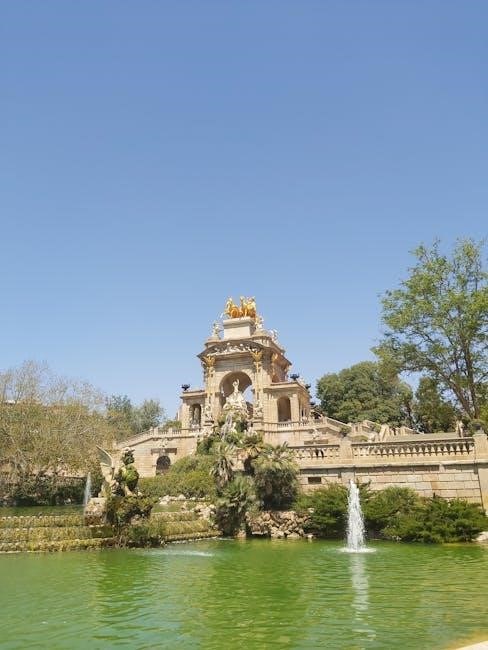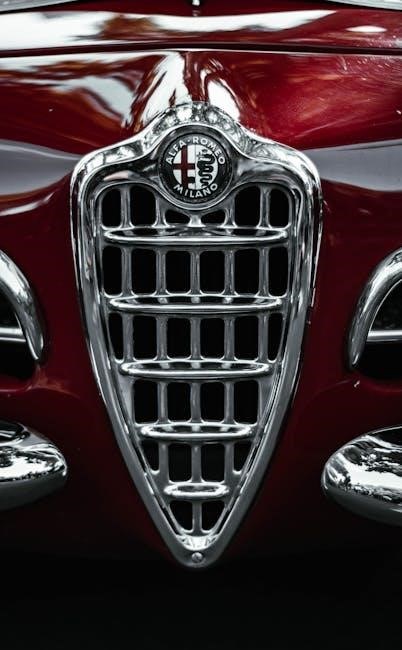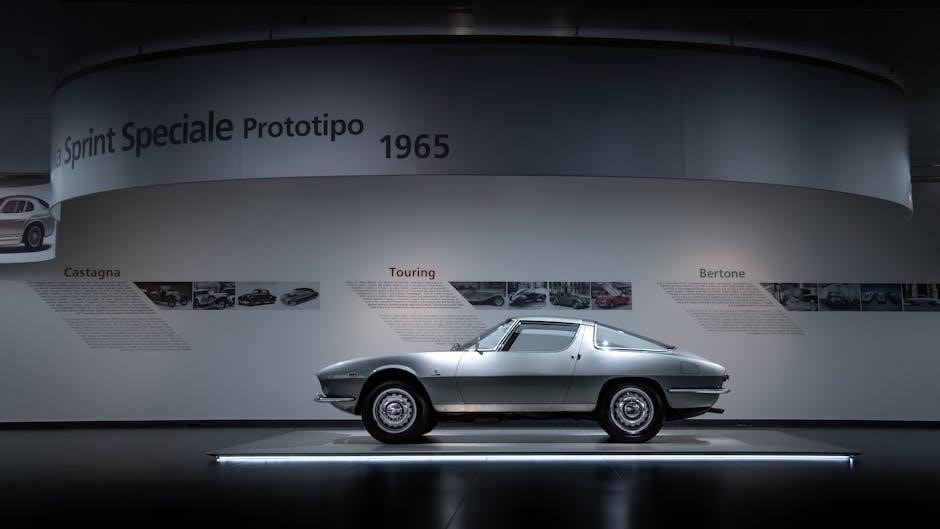The prologue introduces the tragic tale of two feuding households in Verona, setting the stage for a story of doomed love and inevitable conflict.
1.1 The Role of the Prologue in Setting the Stage
The prologue introduces Verona as the setting, highlighting the ancient feud between the Montagues and Capulets. It establishes the tragic tone, outlining the inevitability of conflict and the fate of the star-crossed lovers, Romeo and Juliet. This opening sonnet sets the stage for the audience, guiding their understanding of the play’s themes and structure, while preparing them for the unfolding drama.
1.2 The Chorus as a Narrative Device
The chorus serves as a narrator, delivering the prologue and subsequent interludes, providing context and guiding the audience through the story. Its sonnet structure offers a poetic overview, outlining the central conflict and tragic fate of the lovers. By speaking directly to the audience, the chorus establishes a connection, enhancing the emotional impact and setting the tone for the events unfolding on stage.

Literary Devices in the Prologue
The prologue employs foreshadowing, imagery, and metaphor to create a tragic tone, while the chorus’s sonnet structure adds poetic depth, engaging the audience emotionally from the start.
2.1 Foreshadowing and Tragic Tone
The prologue’s opening lines, “From ancient grudge break to new mutiny,” establish a tragic tone, hinting at inevitable conflict. The phrase “star-cross’d lovers” foreshadows their doomed fate, while “civil blood makes civil hands unclean” highlights the devastating consequences of the families’ hatred, preparing the audience for the heartbreaking events to unfold.
2.2 Use of Imagery and Symbolism
Vivid imagery in the prologue paints Verona as a city tainted by “civil blood,” symbolizing the corruption of its society. The “star-cross’d lovers” imagery evokes celestial conflict, while “ancient grudge” and “mutiny” illustrate deep-seated hatred. These symbols create a rich tapestry, immersing the audience in the play’s emotional and thematic depth, foreshadowing the tragic events through powerful visual language.
Historical and Cultural Context of Verona
Verona’s backdrop of feuding families and societal norms creates a tense atmosphere, reflecting the city’s historical rivalries and political tensions during Shakespeare’s time.
3.1 The Feuding Families: Montagues and Capulets
The prologue highlights the Montagues and Capulets, two noble families embroiled in a bitter, generations-long rivalry. Their hatred escalates violence in Verona, shaping the tragic events.
3.2 Verona as the Setting for Tragedy
Verona’s backdrop of civil strife and bloodshed intensifies the tragic narrative, mirroring the families’ hatred. The city’s atmosphere of tension and conflict foreshadows the inevitable demise of the lovers.

Themes Introduced in the Prologue
The prologue introduces themes of doomed love, family rivalry, and the destructive nature of hate, setting the tone for the tragic events that unfold.
4.1 The Theme of Fate and Star-Crossed Lovers
The prologue highlights fate’s role in the lovers’ lives, labeling them as “star-cross’d,” implying their destiny is predetermined and their tragic end inevitable from the start.
4.2 The Inevitability of Conflict
The prologue emphasizes the deep-seated animosity between the Montagues and Capulets, highlighting how their “ancient grudge” inevitably leads to conflict and violence, setting the stage for the tragic events that unfold in Verona.
The Function of the Chorus
The chorus serves as a guide, offering context and foreshadowing, while setting the tone and preparing the audience for the tragic narrative unfolding in Verona.
5.1 The Chorus as a Guide for the Audience
The chorus acts as a narrator, providing essential background and context, helping the audience understand the complex family feud and impending tragic events in Verona.
5.2 The Chorus’s Sonnet Structure
The chorus delivers its prologue in a traditional Shakespearean sonnet, using a structured rhyme scheme to convey the story’s tragic essence, setting the stage for the ensuing drama.
Key Lines from the Prologue
The prologue features iconic lines like “From ancient grudge break to new mutiny” and “A pair of star-cross’d lovers,” setting the tragic tone and introducing the central conflict.
6.1 “From Ancient Grudge Break to New Mutiny”
This line highlights the enduring feud between the Montagues and Capulets, emphasizing how old rivalries escalate into fresh violence. It sets the stage for the cycle of hatred and revenge that drives the play’s tragic events, while also underscoring the destructive nature of unresolved conflict in Verona. The phrase underscores the inevitability of chaos and bloodshed, foreshadowing the devastating consequences for the star-cross’d lovers.
6.2 “A Pair of Star-Cross’d Lovers”
This iconic line introduces Romeo and Juliet as ill-fated lovers, destined by the stars to suffer a tragic fate. The phrase encapsulates the central theme of the play, emphasizing the inevitability of their doomed love. It evokes a sense of cosmic forces at work, highlighting the helplessness of the lovers against the intertwined threads of fate and family hatred, thus setting the tone for the tragic narrative that unfolds. The imagery of star-cross’d lovers has become synonymous with the timeless tale of love and loss, resonating deeply with audiences and shaping the play’s enduring legacy. The phrase not only underscores the romantic element but also serves as a harbinger of the heartrending conclusion, embedding a sense of inevitability and sorrow from the very beginning. This line is pivotal in establishing the emotional foundation of the story, preparing the audience for the poignant journey of the two protagonists. By referring to the stars, Shakespeare invokes a universal understanding of fate’s power, making the lovers’ plight universally relatable and eternally poignant. The term ‘star-cross’d’ itself has become a cultural reference point, symbolizing lovers destined for tragedy, and its impact extends beyond the play into broader literary and artistic traditions. The phrase’s brevity belies its profound significance, encapsulating the essence of the entire narrative within a few words. It serves as a thematic anchor, reminding the audience of the inescapable fate that awaits the lovers, thereby heightening the dramatic tension and emotional engagement throughout the play. Furthermore, the use of celestial imagery adds a layer of poetic beauty, contrasting sharply with the harsh realities of the feuding families and the ultimate tragedy, thus enriching the play’s emotional and thematic complexity. The phrase’s resonance lies in its ability to transcend time and cultural contexts, making it a cornerstone of the play’s appeal and a testament to Shakespeare’s mastery of language and storytelling; In conclusion, “A Pair of Star-Cross’d Lovers” is more than just a descriptive phrase; it is a thematic linchpin that encapsulates the heart of Romeo and Juliet’s story, influencing how audiences perceive and interpret the events that unfold. The phrase’s profound impact on literature and popular culture underscores its enduring relevance, ensuring that the tale of the star-cross’d lovers remains a timeless classic, continues to captivate audiences, and inspires new adaptations and interpretations across various mediums. The imagery evoked by these words not only sets the stage for the play but also cements its place in the collective cultural consciousness, making it an indelible part of our shared storytelling heritage. In essence, this line is a masterful stroke that succinctly conveys the play’s central themes and tragic inevitability, leaving an indelible mark on the audience’s understanding and appreciation of the narrative. The phrase’s enduring popularity and recognition highlight the universality of its message, transcending the boundaries of time and medium to remain a powerful symbol of doomed yet transcendent love. Through these few words, Shakespeare distills the essence of human emotion and the inexorable forces of fate, creating a phrase that continues to echo through the ages, resonating with each new generation of readers and spectators. The phrase serves as a poignant reminder of the fragility of love in the face of adversity and the unyielding nature of fate, themes that continue to resonate deeply with contemporary audiences. In summary, “A Pair of Star-Cross’d Lovers” is a phrase of immense literary and cultural significance, encapsulating the tragic beauty and inevitable doom of Romeo and Juliet’s love story, and ensuring its place as one of the most recognizable and enduring phrases in all of literature.
The Prologue’s Hint at the Tragic Ending
The prologue foreshadows the tragic conclusion with phrases like “star-cross’d lovers” and “fatal loins,” hinting at the inevitable fate that awaits the young protagonists, setting a somber tone.
7.1 Foreshadowing the Deaths of Romeo and Juliet
The prologue hints at the tragic fate of the lovers through phrases like “star-cross’d” and “fatal loins,” suggesting their deaths are inevitable. This sets a somber tone, preparing the audience for the heartbreaking conclusion that awaits the young protagonists, emphasizing the inescapable destiny that aligns with the feud’s violence.
7.2 The Prologue’s Emotional Impact
The prologue evokes a somber and introspective mood, preparing the audience for the tragic events. Phrases like “star-cross’d lovers” and “civil blood” create a sense of inevitability, fostering empathy and tension. This emotional preparation deepens the audience’s connection to the characters, making the play’s tragic unfolding more poignant and impactful from the outset.

Comparisons with Other Prologues in Shakespeare’s Plays
Shakespeare’s prologues often introduce themes and tone, but Romeo and Juliet’s stands out for its brevity and directness, setting a unique tragic and emotional foundation.
8.1 Similarities with Other Tragic Prologues
Shakespeare’s tragic prologues often introduce conflict and foreshadow events, as seen in Romeo and Juliet. Like other prologues, it uses a chorus to guide the audience, establishing tone and narrative direction. The brevity and directness of Romeo and Juliet’s prologue mirror approaches in plays like Henry V, where the chorus sets the stage for impending drama, blending thematic preview with emotional preparation for the audience.
8.2 Unique Aspects of Romeo and Juliet’s Prologue
Romeo and Juliet’s prologue uniquely blends poetic richness with concise storytelling. Its sonnet structure, with a rhyme scheme and iambic pentameter, distinguishes it from other Shakespearean prologues. The emphasis on fate and the “star-cross’d lovers” creates an immediate emotional connection, setting it apart in both tone and thematic focus, making it one of Shakespeare’s most recognizable and enduring openings.
The Prologue’s Influence on Audience Perception
The prologue immediately shapes the audience’s expectations, establishing a tragic tone and highlighting the inevitability of the lovers’ fate, preparing them emotionally for the unfolding drama.
9.1 Preparing the Audience for the Tragic Narrative
The prologue sets the stage in Verona, introducing the feud and the star-crossed lovers, establishing a tragic tone. It outlines the cycle of hatred and violence between the Montagues and Capulets, while presenting the lovers’ doomed fate, evoking empathy and anticipation. The use of terms like “ancient grudge” and “mutiny” creates a sense of inevitability and foreboding, ensuring the audience is emotionally invested, setting a somber mood and fate’s role.
9.2 Establishing the Play’s Tone and Atmosphere
The prologue’s vivid imagery and somber language create a dark, tense atmosphere, immediately immersing the audience in Verona’s conflict. Phrases like “civil blood” and “unclean” evoke a sense of impending tragedy, while “fatal loins” foretell the devastating consequences. This sets a melancholic tone, preparing the audience for a story driven by passion, hatred, and inevitable sorrow, drawing them into the emotional depth of the play.

The Prologue in Modern Adaptations
Modern adaptations often reframe the prologue using contemporary language and settings, preserving its essence while connecting with today’s audience through relatable themes and styles.
10.1 Contemporary Interpretations of the Prologue
Contemporary adaptations often reimagine the prologue with modern twists, blending traditional themes of fate and conflict with fresh perspectives. Urban slang versions and musical adaptations, like those featuring Shawn Mendes, emphasize relatable emotions while maintaining the prologue’s timeless essence, connecting its universal themes to today’s audience through innovative storytelling and cultural relevance.
10.2 The Prologue in Film and Stage Adaptations
Film and stage adaptations often creatively interpret the prologue, using voiceovers, visuals, or chorus performances to establish setting and tone. Modern productions, such as those using urban slang, maintain the original’s emotional depth while appealing to diverse audiences, ensuring the prologue’s enduring relevance in both traditional and contemporary mediums, thus preserving its impact across various artistic expressions.
The Prologue’s Connection to the Rest of the Play
The prologue lays the groundwork for the entire narrative, introducing the central conflict and themes of fate, love, and tragedy that resonate throughout the play.
11.1 How the Prologue Reflects Themes in Subsequent Acts
The prologue mirrors themes of fate and conflict seen in later acts, as Romeo and Juliet’s doomed love unfolds, echoing the “star-cross’d” curse and intensifying the tragic atmosphere through their ultimate demise, which underscores the inevitability of their fate and the destructive nature of the families’ feud, aligning with the prologue’s ominous tone.
11.2 The Prologue’s Role in Shaping Character Dynamics
The prologue establishes the animosity between Montagues and Capulets, shaping the characters’ motivations and interactions. It introduces Romeo and Juliet as star-cross’d lovers, defining their tragic fate and influencing their impulsive decisions. The prologue’s emphasis on familial hatred and doomed love sets the stage for the intense emotional dynamics and inevitable conflicts between the characters, aligning their actions with the play’s tragic trajectory.

Educational Significance of the Prologue
The prologue introduces themes, literary devices, and sets the tone, making it a valuable tool for teaching students about dramatic structure and thematic elements effectively.
12.1 Teaching the Prologue in Schools
The prologue is often taught in schools to introduce students to Shakespeare’s use of literary devices, thematic elements, and dramatic structure. Educators use it to explain foreshadowing, imagery, and the historical context of Verona’s feuding families. Modern adaptations, like Romeo and Juliet in Urban Slang, help students connect with the material, making the prologue a foundational tool for understanding the play’s deeper themes and conflicts.
12.2 Analytical Approaches to the Prologue
Analysts often explore the prologue’s use of sonnet structure and its role in establishing tone. The Chorus’s narrative device provides insight into themes of fate and conflict. By examining specific lines like “star-cross’d lovers,” scholars highlight Shakespeare’s mastery of foreshadowing and emotional impact, offering a deeper understanding of the play’s tragic foundation and universal appeal to audiences across centuries.
The Prologue’s Legacy in Literature
The prologue’s enduring influence on literature is evident, establishing timeless themes and inspiring countless adaptations and modern narratives in various artistic forms.
13.1 The Prologue’s Impact on Literary Tradition
The prologue of Romeo and Juliet has become a foundational element in literary tradition, influencing countless adaptations and works. Its concise yet powerful narrative structure has inspired authors to adopt similar devices, making it a model for introducing themes and conflicts. The prologue’s timeless themes of fate and conflict continue to resonate, solidifying its place as a cornerstone of tragic storytelling in literature and beyond.
13.2 The Prologue as a Model for Modern Writing
The prologue’s structure and poetic language have served as a blueprint for modern writers seeking to encapsulate themes and foreshadow events. Its use of sonnet form and vivid imagery offers a concise yet impactful narrative technique. Many contemporary adaptations, including urban slang versions, draw inspiration from its style, proving its enduring influence on creative storytelling and literary adaptations across genres and mediums.
The prologue of Romeo and Juliet masterfully sets the stage for a tragic narrative, employing literary devices to foreshadow events and establish themes, leaving a lasting impact on audiences and adaptations alike.
14.1 The Prologue’s Enduring Relevance
The prologue remains a cornerstone of literary analysis, offering insights into themes of fate, conflict, and doomed love. Its poetic structure and rich imagery continue to inspire modern adaptations and educational studies, ensuring its timeless appeal and universal relevance across generations and artistic interpretations.
14.2 Final Thoughts on the Prologue’s Importance
The prologue is a masterful introduction, guiding the audience into the heart of the play. By setting the tone, introducing themes, and previewing the tragic outcome, it establishes the emotional and narrative foundation. Its poetic beauty and structural precision make it a pivotal element, ensuring its study and appreciation remain essential in both academic and theatrical contexts.
